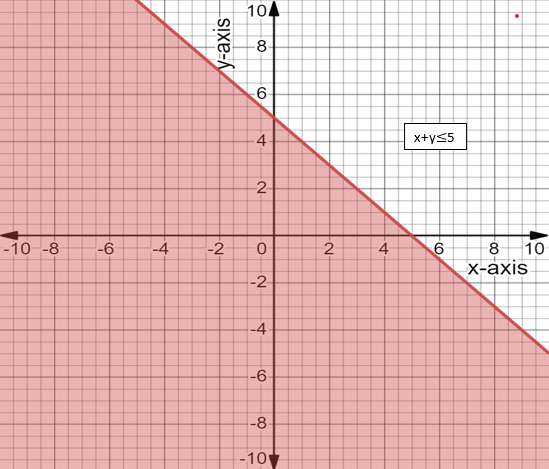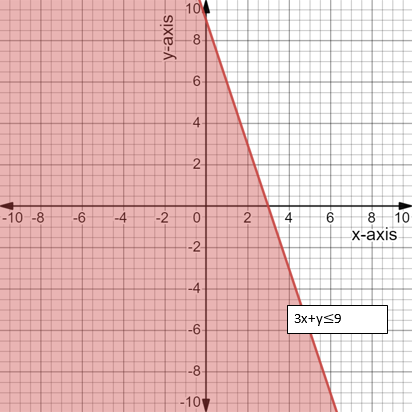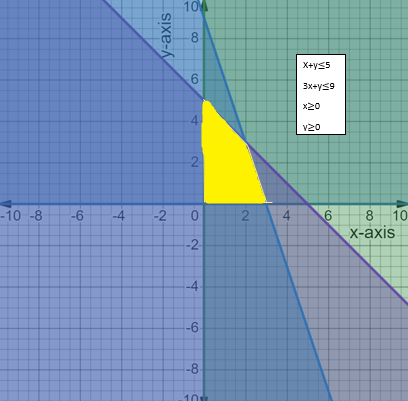
Maximum value of \[z = 12x + 3y\], subject to constraints \[x \geqslant 0\], \[y \geqslant 0\], \[x + y \leqslant 5\] and \[3x + y \leqslant 9\] is
A. \[15\]
B. \[36\]
C. \[60\]
D. \[40\]
Answer
217.5k+ views
Hint: In this question, create the given lines on graph paper and remember that the optimal value is located on the graph's corner to find the value of the target function at the graph's corners to determine the target function's maxima.
Complete step-by-step solution:
We are given that \[z = 12x + 3y\] subject to constraints
\[
x \geqslant 0, \\
y \geqslant 0, \\
x + y \leqslant 5\,\,\,and \\
3x + y \leqslant 9
\]
Now we plot \[x + y \leqslant 5\,\] on the graph:
When \[x = 0\] we have
\[
x + y = 5 \\
0 + y = 5 \\
y = 5
\]
When \[y = 0\] we have
\[
x + y = 5 \\
x + 0 = 5 \\
x = 5
\]
Therefore, two points on the line are \[\left( {0,5} \right)\left( {5,0} \right)\]
To check the feasible region we will consider origin and substitute in the inequality. If it holds true then the region which contains origin will be feasible region and if it doesn’t hold true then the region which doesn’t contains origin will be feasible region.
\[x + y \leqslant 5\,\]
\[0 + 0 \leqslant 5\,\]
So inequality holds true.
Now by plot these points on the graph, we get

Image: Graph of linear inequality \[x + y \leqslant 5\,\]
Now we plot \[3x + y \leqslant 9\] on the graph:
When \[x = 0\] we have
\[
3x + y = 9 \\
3\left( 0 \right) + y = 9 \\
y = 9 \\
\]
When \[y = 0\] we have
\[
3x + 0 = 9 \\
3x = 9 \\
x = \dfrac{9}{3} \\
x = 3 \\
\]
Therefore, two points on the line are \[\left( {0,9} \right)\left( {3,0} \right)\]
To check the feasible region we will consider origin and substitute in the inequality. If it holds true then the region which contains origin will be the feasible region and if it doesn’t hold true then the region which doesn’t contain origin will be the feasible region.
\[3x + y \leqslant 9\,\]
\[0 + 0 \leqslant 9\,\]
So inequality holds true.
Now by plot these points on the graph, we get

Image: Graph of linear inequality \[3x + y \leqslant 9\,\]
Also, we have \[x \geqslant 0,y \geqslant 0\]

Image: Graph of linear inequalities \[3x + y \leqslant 9\,\] and \[x + y \leqslant 5\,\]
Now we find the value of x and y:
We have two given equations
\[
x + y \leqslant 5 \\
3x + y \leqslant 9 \\
\]
Now we can write these equation as:
\[
x + y = 5...\left( 1 \right) \\
3x + y = 9...\left( 2 \right) \\
\]
Now by subtracting equation (1) from equation (2), we get
\[
3x + y - x - y = 9 - 5 \\
2x = 4 \\
x = \dfrac{4}{2} \\
x = 2 \\
\]
Now we substitute the value of x in equation (1), we get
\[
2 + y = 5 \\
y = 5 - 2 \\
y = 3 \\
\]
Thus the value of x and y is:
\[
x = 2 \\
y = 3
\]
Now we know that the maxima are the maximum value of a function within the given set of ranges. We will check on all the corner points of the feasible region.
At (0, 0), the value of Z = 0.
At (0, 5), the value of Z = 15.
At (3, 0), the value of Z = 36.
And at (2, 3), the value of z,
\[
z = 12x + 3y \\
= 12\left( 2 \right) + 3\left( 3 \right) \\
= 24 + 9 \\
= 33
\]
Therefore, the maximum value is 36.
Hence, option (B) is correct answer
Note: It is critical for the solution of a linear programming problem to keep the constraints variables non-negative. The simplex method can also be used to find the maxima of the above problem. The simplex method is an algorithmic process for solving linear programming problems.
Complete step-by-step solution:
We are given that \[z = 12x + 3y\] subject to constraints
\[
x \geqslant 0, \\
y \geqslant 0, \\
x + y \leqslant 5\,\,\,and \\
3x + y \leqslant 9
\]
Now we plot \[x + y \leqslant 5\,\] on the graph:
When \[x = 0\] we have
\[
x + y = 5 \\
0 + y = 5 \\
y = 5
\]
When \[y = 0\] we have
\[
x + y = 5 \\
x + 0 = 5 \\
x = 5
\]
Therefore, two points on the line are \[\left( {0,5} \right)\left( {5,0} \right)\]
To check the feasible region we will consider origin and substitute in the inequality. If it holds true then the region which contains origin will be feasible region and if it doesn’t hold true then the region which doesn’t contains origin will be feasible region.
\[x + y \leqslant 5\,\]
\[0 + 0 \leqslant 5\,\]
So inequality holds true.
Now by plot these points on the graph, we get

Image: Graph of linear inequality \[x + y \leqslant 5\,\]
Now we plot \[3x + y \leqslant 9\] on the graph:
When \[x = 0\] we have
\[
3x + y = 9 \\
3\left( 0 \right) + y = 9 \\
y = 9 \\
\]
When \[y = 0\] we have
\[
3x + 0 = 9 \\
3x = 9 \\
x = \dfrac{9}{3} \\
x = 3 \\
\]
Therefore, two points on the line are \[\left( {0,9} \right)\left( {3,0} \right)\]
To check the feasible region we will consider origin and substitute in the inequality. If it holds true then the region which contains origin will be the feasible region and if it doesn’t hold true then the region which doesn’t contain origin will be the feasible region.
\[3x + y \leqslant 9\,\]
\[0 + 0 \leqslant 9\,\]
So inequality holds true.
Now by plot these points on the graph, we get

Image: Graph of linear inequality \[3x + y \leqslant 9\,\]
Also, we have \[x \geqslant 0,y \geqslant 0\]

Image: Graph of linear inequalities \[3x + y \leqslant 9\,\] and \[x + y \leqslant 5\,\]
Now we find the value of x and y:
We have two given equations
\[
x + y \leqslant 5 \\
3x + y \leqslant 9 \\
\]
Now we can write these equation as:
\[
x + y = 5...\left( 1 \right) \\
3x + y = 9...\left( 2 \right) \\
\]
Now by subtracting equation (1) from equation (2), we get
\[
3x + y - x - y = 9 - 5 \\
2x = 4 \\
x = \dfrac{4}{2} \\
x = 2 \\
\]
Now we substitute the value of x in equation (1), we get
\[
2 + y = 5 \\
y = 5 - 2 \\
y = 3 \\
\]
Thus the value of x and y is:
\[
x = 2 \\
y = 3
\]
Now we know that the maxima are the maximum value of a function within the given set of ranges. We will check on all the corner points of the feasible region.
At (0, 0), the value of Z = 0.
At (0, 5), the value of Z = 15.
At (3, 0), the value of Z = 36.
And at (2, 3), the value of z,
\[
z = 12x + 3y \\
= 12\left( 2 \right) + 3\left( 3 \right) \\
= 24 + 9 \\
= 33
\]
Therefore, the maximum value is 36.
Hence, option (B) is correct answer
Note: It is critical for the solution of a linear programming problem to keep the constraints variables non-negative. The simplex method can also be used to find the maxima of the above problem. The simplex method is an algorithmic process for solving linear programming problems.
Recently Updated Pages
Elastic Collision in Two Dimensions Explained Simply

Elastic Collisions in One Dimension Explained

Electric Field of Infinite Line Charge and Cylinders Explained

Electric Flux and Area Vector Explained Simply

Electric Field of a Charged Spherical Shell Explained

Electricity and Magnetism Explained: Key Concepts & Applications

Trending doubts
JEE Main 2026: Application Form Open, Exam Dates, Syllabus, Eligibility & Question Papers

Derivation of Equation of Trajectory Explained for Students

Hybridisation in Chemistry – Concept, Types & Applications

Understanding the Angle of Deviation in a Prism

Understanding Collisions: Types and Examples for Students

How to Convert a Galvanometer into an Ammeter or Voltmeter

Other Pages
JEE Advanced Marks vs Ranks 2025: Understanding Category-wise Qualifying Marks and Previous Year Cut-offs

Understanding Atomic Structure for Beginners

Ideal and Non-Ideal Solutions Explained for Class 12 Chemistry

Degree of Dissociation: Meaning, Formula, Calculation & Uses

Understanding Electromagnetic Waves and Their Importance

Understanding the Electric Field of a Uniformly Charged Ring




